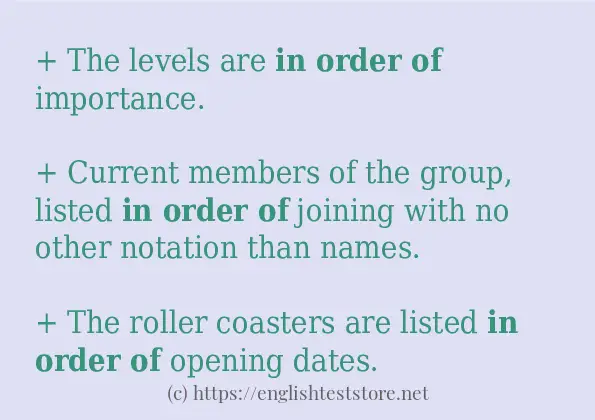How to use in-sentence of “in order of”:
+ The levels are in order of importance.
+ Current members of the group, listed in order of joining with no other notation than names.
+ The roller coasters are listed in order of opening dates.
+ The benches are put in order of the victim’s years of birth.
+ Bach arranged the two groups of pieces in order of ascending key.

Example sentences of “in order of”:
+ Children in the concrete operational stage can also put things in order of qualities like length and weight.
+ Sorted in order of area size.
+ Former known names of Céret are, in order of appearance, “vicus Sirisidum” in 814, “vico Cereto” in 866, “villa Cerseto” in 915, “vigo Ceresido” in 930, also “Cered” and “Ceriteto” in the 10th century, “Ceret”, “Cericeto” in the XIth and XIIth centuries, “Cirset” around 1070, “Cersed” in 1130 and “Cerset” in 1138, and from the XIIIth to the XVth centuries “Cereto”, “Ceret”, “Seret” and “Saret”.
+ The letters follow phonetically, in order of sound.
+ At the head of the list are the three city cantons that were considered preeminent in the Old Swiss Confederacy; the other cantons are listed in order of accession to the Confederation.
+ Past members of the group, listed in order of joining with no other notation than names.
+ List the figures in order of organizational role importance.
+ The list of best-selling PlayStation video games are listed in order of greatest to least best-selling video game.
+ Although listed in order of complexity, the ideas can be applied in any order.
+ The organ pieces in the collection are arranged in order of difficulty.
+ Children in the concrete operational stage can also put things in order of qualities like length and weight.
+ Sorted in order of area size.
+ Former known names of Céret are, in order of appearance, "vicus Sirisidum" in 814, "vico Cereto" in 866, "villa Cerseto" in 915, "vigo Ceresido" in 930, also "Cered" and "Ceriteto" in the 10th century, "Ceret", "Cericeto" in the XIth and XIIth centuries, "Cirset" around 1070, "Cersed" in 1130 and "Cerset" in 1138, and from the XIIIth to the XVth centuries "Cereto", "Ceret", "Seret" and "Saret".
